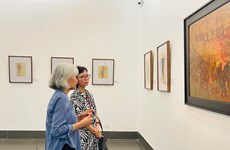Da Lat says it with flowers, once again
Ten times out of 10, the place will be Da Lat.
In the last days of the year, Da Lat wears an even more romantic look
than usual. As the soft, yellow sunlight, the gentle breeze that
softens the chilly air and yes, yes, the ubiquitous flowers, as all
these induce a mellowness inside you, you notice that the residents
themselves are not relaxing.
Indeed, they are
bustling about, making hectic, last-minute preparations to make sure
that the premier event of the Central Highland resort city, the biennial
Flower Festival – the city's pride and joy – is even more spectacular
than the last edition.
The festival kicks off on New
Year's Eve, adding further zest to the proceedings. One can see that the
city is going to be ablaze with colours very soon.
Located on the Lam Vien (Langbian) Plateau (1,500 metres above the sea
level) with the year-round cool and fresh weather, Da Lat keeps
collecting titles as though it is its entitlement.
It is the City of Flowers, the City of Pines and the City of Love - and
because of the mist that covers its valley almost throughout the year,
it is also the City of Eternal Spring.
Da Lat's soil
and average temperatures of 18 degrees Celcius have been fertile ground
for its flower industry, which grows more than 400 species that
flourish in tropical and temperate climates.
The twisting roads that wind their way through the city's hilly terrain only increase the Da Lat's numerous charms.
The flowers that are the city's crowning glory are not just found in
gardens and nurseries, they grow wild on roadsides, in window sills,
from cracks in the walls, and every patch of land that is available.
While tulips, dahlias, orchids and chrysanthemums are
typical commercial crops, there are others, like the mai anh dao (Prunus
cesacoides), phuong tim (Jacaradanda), yellow mimosa (Silver Wattle)
and ban trang (Bauthinia Variegata), that brighten up the city at
different times of the year.
Then there are the cam
tu cau (Hotensia), cuc (daisy), do quyen (Water-rail) and rose,
adornments that the city decorates itself with from time to time.
The Da Lat Flower Festival, which draws thousands of domestic and
international visitors to the city every year, honours both the
profession of horticulture and the horticulturists - the farmers and
artisans - who have made it one of two largest floral shows in Asia
alongside a similar event in Hong Kong.
Nguyen Xuan
Tien, chairman of the Lam Dong province People's Committee, said:
"Flowers and growers have always been close to Da Lat's entire
development process. They have provided all kinds of flowers to the
city, which now has thousands of species with origins elsewhere in the
country as well as many other countries in the world.
"They are making important contributions to the province's
socio-economic development, and enabling the Da Lat Flower brand become
famous at home and abroad."
This year's flower
festival, the fifth, is expected to be the biggest one to date as it
greets several other important events - both national and pertaining to
Da Lat City in particular. These include the first Vietnam-Asia Heritage
Festival, the launch of the National Tourism Year and the celebration
of the 120th year of founding and development of Da Lat.
Of course, farmers in the city are kept the busiest of all by the flower festival.
In Thai Phien village which is a traditional daisy planting community,
farmers are busy taking care of more than 30 hectares of daisy, lily
and carnation fields so as to have the flowers ready for display at the
event.
Ho Ngoc Dinh, president of the local
farmers' association, said the village will also welcome tourists who
want to visit it and learn more about its vocational and other
traditions.
Farmers in Van Thanh village, meanwhile,
plan to create a 120m long "rose road" to greet the festival. The road
will be arranged with several parterres at which the village's typical
species of roses including velvety, pink and white roses will be
planted.
Villagers will also prepare various types
of floral products including dry flowers and flower paintings to serve
visitors at the festival.
"We're doing lots of
things to make Da Lat as pretty as possible," said a member of the Da
Lat Flower Festival 2014 organising committee.
"We
expect to mobilise at least 1.3 million flower farming units, including
enterprises and household businesses, to participate in the festival.
The figure is nearly three times more than in 2005."
He said the city now has 3.5 million enterprises involved in producing
and trading flowers and they are ready to supply products for the
festival.
"However, we still encourage neighbouring
provinces and foreign companies to bring their flower products to the
event to increase everyone's enjoyment.
"To date,
foreign flower companies mainly from Japan, China, the Republic of Korea
and Thailand have accepted our invitation."
The
Da Lat urban works management company will be responsible for setting
up large panels of flowers and floral towers in the city.
The Da Lat Flower Garden, where the international flower exhibition
will take place, is being rearranged and parterres are being replanted
to make sure that the flowers will bloom at festival time.
All households in Da Lat have been encouraged to grow flowers and
apricot trees along the city's main streets are being cared for by
horticulturists so they bloom just in time.
Flower power
Da Lat has six traditional flower villages - Ha Dong, Thai Phien, Da
Thien, An Son, Van Thanh and Xuan Tho - that grow similar varieties of
flowers and specialise in a few others.
Pham Van An,
director of Lam Dong province's Department of Agriculture and Rural
Development, said that the flower cultivation area in the province,
mainly Da Lat, had doubled from 1,731ha in 2003 to nearly 4,000ha with
an output of about 14 billion bunches of flowers at present. Of these,
52 million are exported for a turnover of 25 million USD.
In addition to traditional markets such as Singapore, China and Japan,
Da Lat's well-known flowers like roses, lilies, orchids and daisies
have also been exported to Europe and North America, An said.
In December 2009, the Department of Intellectual Property under the
Ministry of Science and Technology granted the "Hoa Da Lat" (Da Lat
Flowers) brand to the Lam Dong People's Committee.
The brand, deemed a common asset of the community of Da Lat producers
and traders, is managed by the Da Lat People's Committee.
"In recent years, flower growers in the city have enhanced the
application of advanced technology in farming, packaging and
preservation, improving yield and quality as well as reducing
post-harvest losses so that Da Lat flowers could gain international
recognition," An said.
Nguyen Minh Tam, deputy
director of the Lam Dong Department of Science and Technology, said that
although Da Lat flowers are well-known in both domestic and overseas
markets, building a strong Da Lat Flower brand is still a major task for
local authorities and flower growers.
As a result,
the Hoa Da Lat brand received the certificate by the Department of
Intellectual Property in 2012. It has since become a common asset of
flower growers and other residents, and is managed by the People's
Committee.
Recently, five more flower species widely
grown in Da Lat - roses, chrysanthemum, bluebell, clove pink and sword
lily - were allowed to bear the Da Lat Flower brand name, said Duong
Ngoc Duc, head of the economic bureau under the Da Lat People's
Committee.
Forty-two individuals and facilities that
grow the above flowers will now be allowed to use the brand on the
packaging and promoting their products for three years.
Ha Van Dong, 62, one of several famous flower growers in Da Lat, said
farmers in Ha Dong Village cultivate mostly chrysanthemums but have also
reserved some land for lisianthus.
"My parents
began growing flowers in the 1960s, but it only became a profitable
business in 1996 when we decided to develop some new flower varieties
and use greenhouses," he said.
This year, his family
will show off 1,000 chrysanthemum and lisianthus flowers at Xuan Huong
Lake, Dong said and adding, "We are working very hard to look after the
flowers so that they bloom during the festival. It is very difficult but
we have to try."
Nguyen Hung Vinh, a farmer from Da
Thien 3 Village, said that up to 80 percent of the village's households
grow flowers, mostly rose, chrysanthemum, orchid, carnation and
gerbera.
"We have prepared hard to display some 10
varieties of flowers at the festival. We really want to make our city
more beautiful than ever," he added.-VNA













